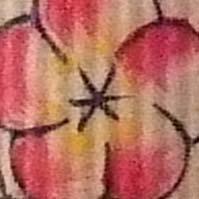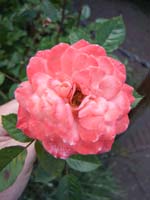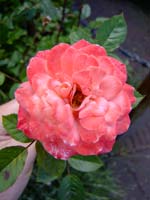Fujifilm FinePix S100FS Review
Review Date: July 15th 2008
Author: Gavin Stoker
Leave a comment about this Review
|
Image Quality
All of the sample images in this Review were taken using the 11M (3840 x 2880) JPEG image size option., which gives an average image size of around 5Mb.
The first thing to point out is that, when there�s plenty of light around and you don�t have to rely on image stabilisation too drastically, the Fujifilm FinePix S100FS is great for candids and otherwise tricky-to-achieve framing � that 14.3x zoom allowing the user to literally pluck the birds out of the trees or gain more naturalistic portraiture � suggesting the camera as an ideal tool for those who like a more reportage-style feel to their photography. If you want cheesy, posed portraits however, the S100FS can do that too, and the fact that face detection comes automatically coupled with red eye reduction (though you can turn the latter off and still utilize face detection if you don�t like the results) is a boon for those who occasionally just want to use the S100FS for snapshots.
As you�d expect from a Fujifilm model at this level � and what impressed us with the S5 Pro � is both the level of detail delivered (images generally possessing a good depth of field and a sharp, crisp finish with the camera left to its default settings), and moreover the colours, providing a result closer to that perceived by the human eye than expected. Which isn�t to say that the hues are flatteringly warm or coldly naturalistic � the overall sense is what�s delivered is between the two and spot on. And, if you do want a particular effect, both sharpness and colour can be tweaked to the nth degree courtesy of the settings we�ve already run through. When it�s really bright out however the camera will err on the side of underexposure to preserve foreground and background detail, but exposures are generally even and purple fringing too is well controlled � though it�s there on occasion if you really look.
In terms of ISO performance, the Fujifilm FinePix S100FS' auto settings are spot on accurate, but when running through the range of manual choices stick to ISO 800 or below if you want to avoid noise. That said, the S100FS makes a cleaner fist of it than most, its performance at ISO 1600 equivalent to some rivals at ISO 800, and ditto ISO 3200. Photographers will want to avoid the impression of a building sandstorm provided by ISO 6400 and the smeared detail (and resolution drop anyway) at the frankly unnecessary ISO 10000. The S100FS may deliver a respectable performance, but despite Fuji�s pioneering approach to delivering higher ISOs and lower noise, it's no Nikon D300 or D3. Still, for general-purpose photography � if you don�t mind lugging around a camera that requires its own bag � then the Fujifilm FinePix S100FS, image wise at least, is hard to beat.
Noise
There are 8 ISO settings available on the Fujifilm FinePix S100FS. Stick to ISO 800 or below if you want to avoid noise. That said, the S100FS makes a cleaner fist of it than most, its performance at ISO 1600 equivalent to some rivals at ISO 800, and ditto ISO 3200. Photographers will want to avoid the impression of a building sandstorm provided by ISO 6400 and the smeared detail (and resolution drop anyway) at the frankly unnecessary ISO 10000. Here are some 100% crops which show the noise levels for each ISO setting:
ISO 100 (100% Crop) |
ISO 200 (100% Crop) |
 |
 |
ISO 400 (100% Crop) |
ISO 800 (100% Crop) |
 |
 |
ISO 1600 (100% Crop) |
ISO 3200 (100% Crop) |
 |
 |
ISO 6400 (100% Crop) |
ISO 10000 (100% Crop) |
 |
 |
Sharpening
Here are two 100% crops which have been Saved as Web - Quality 50 in Photoshop. The right-hand image has had some sharpening applied in Photoshop. The out-of-the camera images are perfectly fine at the default sharpening setting, and don't really benefit from any further sharpening in a program like Adobe Photoshop. You can also change the in-camera sharpening level.
Original
(100% Crop) |
Sharpened (100% Crop) |
 |
 |
 |
 |
Chromatic Aberrations
The Fujifilm FinePix S100FS dealt well with chromatic aberrations during the review, with limited purple and cyan fringing present around the edges of objects in certain high-contrast situations, especially at the telephoto end of the 14x zoom.
Chromatic
Aberrations
1 (100% Crop) |
Chromatic
Aberrations
2 (100% Crop) |
 |
 |
Macro
The Fujifilm FinePix S100FS offers a Super-Macro setting that allows you to focus on a subject that is just 1cm away from the camera when the lens is set to wide-angle. The first image shows how close you can get to the subject (in this case a compact flash card). The second image is a 100% crop.
Macro |
Macro (100% Crop) |
 |
 |
Flash
The flash settings on the Fujifilm FinePix S100FS are Auto, Forced Flash, Slow Synchro, Red-eye Reduction Auto, Red-eye Reduction & Forced Flash. These shots of a white coloured wall were taken at a distance of 1.5m.
Flash Off - Wide Angle (28mm) |
Auto Flash - Wide Angle (28mm) |
 |
 |
Flash Off - Telephoto (400mm) |
Auto Flash - Telephoto (400mm) |
 |
 |
And here are some portrait shots. As you can see, the Forced Flash setting caused a tiny amount of red-eye, which the Red-Eye Reduction option completely removed.
Forced Flash |
Forced Flash (100% Crop) |
 |
 |
Red-Eye Reduction |
Red-Eye Reduction (100% Crop) |
 |
 |
Night Shot
The Fujifilm FinePix S100FS maximum shutter speed is 30 seconds, which is good news if you're seriously interested in night photography. The shot below was taken using a shutter speed of 3 seconds at ISO 400. I've included a 100% crop of the image to show what the quality is like.
Night Shot |
Night Shot (100% Crop) |
 |
 |
Film Simulation Bracketing
The FSB mode, or 'film simulation bracketing', allows the same image to be captured in different colours or tones, ape-ing the looks of Fuji's popular Provia or Velvia film (the latter offering higher brightness and sharpness), or alternatively opt for 'Soft', providing a romantic look with muted colours. Arguably this is one of the key features that sets the S100FS apart from other contenders, and could be a decider for those who want that Fuji signature look and feel. I've included a 100% crop of the image to show what the quality is like.
| Provia | Velvia | Soft |
 |
 |
 |
 |
 |
 |
|
![]() PhotographyBLOG
is a member of the DIWA
organisation. Our test results for the Fujifilm FinePix S100FS have
been submitted to DIWA
for comparison with test results for different samples of
the same camera model supplied by other DIWA
member sites.
PhotographyBLOG
is a member of the DIWA
organisation. Our test results for the Fujifilm FinePix S100FS have
been submitted to DIWA
for comparison with test results for different samples of
the same camera model supplied by other DIWA
member sites.
